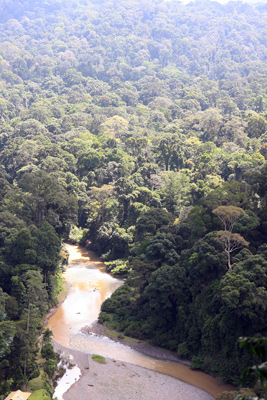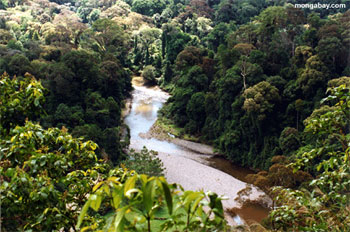What you do to help save rainforests
What you do to help save rainforests
Rhett A. Butler, mongabay.com
April 22, 2008
|
|
Most people understand that tropical rainforests are critically important in regulating rainfall and global climate, while providing habitat for millions of species and unique indigenous cultures. Yet despite this significance, rainforests continue to be destroyed at a furious pace — in 2008 Brazil and Indonesia are expected to each lose at least 8 million acres of forest cover.
Is there anything an individual can do to help save the majestic forests of the Amazon, the Congo, and Southeast Asia? Thankfully, there is. Here is a look at some small actions that can help tropical forests.
Reduce, reuse, and recycle
First, it is important to realize that the usual steps to reduce your ecological footprint at home indirectly benefit rainforests half a world away by reducing resource consumption, which in the end is the ultimate driver of most forest destruction today. Therefore conserving energy and water; recycling; walking, riding a bike, or using public transportation instead of driving; and curtailing unnecessary purchases of products are all things that help avoid contributing to global deforestation.

Borneo rainforest. Under the auspices of a new international climate agreement, rainforest conservation may emerge as a far more interesting way to “offset” your emissions than conventional carbon credits. Photo by Rhett A. Butler / mongabay.com |
In some cases your impact on rainforests may be more direct — many wood and paper products are derived from rainforest trees. While it’s notoriously difficult to determine the origin of such products, make it a policy to learn as much as your can about the products you buy by doing research online. At present, it’s safest to avoid tropical hardwoods (like mahogany) unless they have been certified as having been produced in an environmentally responsible way (though even certification isn’t fool-proof). Better yet, work to minimize your use of paper and wood in the first place through recycling and re-use (i.e. double-sided printing). Look for products made from recycled materials (some wood “composites” incorporate recycled plastics) or buy used.
While this will come as a no-brainer to the eco-conscious, don’t buy products made from rainforest animal skins or parts. Don’t purchase exotic pets that have been collected from the wild. You can ask pet stores whether animals are “wild-caught” or “captive bred.” With “captive bred”, you can have the peace of mind that your pet has not been torn from its natural habitat.
Supporting rainforest conservation efforts
As a consumer you can take a pro-active approach to supporting rainforests by purchasing products linked to conservation efforts. For example, studies have show that shade-grown coffee and cacao support higher levels of biodiversity than conventionally grown monocultures. Accordingly, a number of companies and organizations offer rainforest-friendly coffee and chocolate, but offerings will likely be significantly expanded in coming years. For now, the Rainforest Alliance web site is an excellent starting point for learning more about certified products.
Travel

Earth Day: Another gimmick day full of false promises and empty pledges or a day for reflection? |
Travel is another way to ensure that rainforests are protected as intact ecosystems. Look for eco-friendly and socially responsible operators that follow guidelines for ecotourism and are run by, or at least employ, local people. Rainforest Expeditions in Peru is a great example, but check out Whole Travel for other ideas.
If international travel is too expensive or the idea of increasing your carbon footprint is too much to bear, try a visit to a local zoo, especially if it is involved in conservation efforts. As an alternative, look around your neighborhood for local rainforest residents. Many song birds spend at least part of the year in the tropics — figuring out which ones are the migrants can be a great learning experience for kids and can demonstrate how the health of rainforests directly impacts your local community. As forests fall, migratory birds lose their nesting grounds and fewer return to temperate areas.
Donate and get educated
Donate time and money to organizations working to ensure that rainforests are around for future generations. Look for groups that have a local impact and don’t have a lot of overhead. The Amazon Conservation Team, which works with tribes in the Amazon to protect culture and forest, is a great example.
Learn more about rainforests — why they are important and what’s happening to them. Spread the word to your friends and colleagues